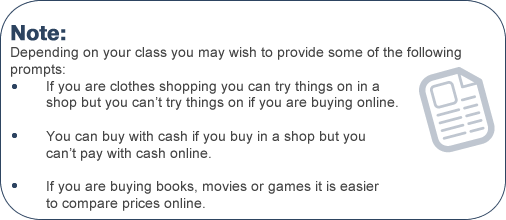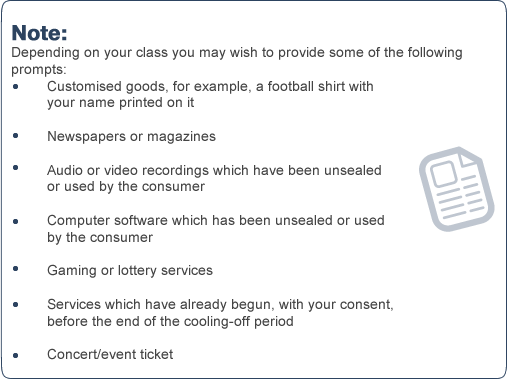Lesson 3: Your rights when shopping online
Introduction

Time:
- Single class period
Materials:
Activity 2: Online shopping rights
- Teacher Resource Sheet: Online shopping statements
- Teacher Resource Sheet: Online shopping information
Homework Task:
Useful Links:
Introduction:
Lots of people regularly buy online. They buy clothes, books, movies, games. They book flights, hotels and rent cars. This lesson will help students become familiar with their consumer rights when shopping online and make them aware that there are differences in the rights people have when shopping online and buying directly in a shop.
Step-By-Step Instructions

Activity 1: What’s the difference?
1. Ask the class whether or not it is common for people their age to buy online. What kinds of goods/services do young people buy online?
2. Divide the class into pairs and ask each pair to come up with a list of things that make buying online different to buying in a shop.

3. Take feedback from a selection of student-pairs, noting their responses on the white/blackboard.
Activity 2: Online shopping rights
1. Tell students because buying online is getting more popular everyone should know what consumer rights they have when shopping online. Explain when you buy something online, there is a physical distance between you and the seller. This is different to buying something in a shop where you interact with someone face-to-face. If you have bought something from a business that is based in the EU, you are protected by EU law. If it’s up to 14 calendar days since you received your purchase, you will be covered under the Consumer Rights Act by the cooling-off period and can return the goods and get a refund. However, if you are cancelling the order because you’ve changed your mind, you may have to pay for the cost of returning the goods.
2. Explain some things you buy online are not covered by the 14-day cooling-off period rule. E.g. perishable goods (goods which can go off, like frozen food or flowers).
3. Ask students to name other goods or services, which might not be covered by the 14-day cooling-off period.

4. Place a page with the word ‘True’ at one end of the classroom and a page with the word ‘False’ at the other end of the classroom.

5. Invite students to stand in the middle of the room.
6. Explain you are going to call out a series of statements relating to shopping online. If they think the statement is true they should move to stand beside the ‘True’ poster. If they think the statement is false they should move to stand beside the ‘False’ poster. They can also choose to stand at any point between the two posters, if they are unsure or think that there may be exceptions to the statement.
7. Call out each statement from Teacher resource sheet: Online shopping statements and invite a sample of students from each of the locations in the classroom to discuss their opinions on the statement. At the end of each discussion provide the correct answer for each statement using the information provided in Teacher resource sheet: Online shopping information.
8. Invite students to sit down.
9. Facilitate a brief class discussion using the following questions as prompts:
- Do you think the class was well-informed about their online shopping rights?
- Were you surprised by any of the information about online consumer rights?
10. Conclude by asking students to respond to the following statement:
‘Legal rights are only an advantage if you know about them’
Homework Task

When a company is selling online they have to provide certain information. Invite students to think of clothes companies with online shops. Explain their homework is to research one of these online clothes companies to see if they provide all the information required.
Students are to imagine they are buying an item of clothing online from this shop.
Distribute one copy of Homework Task: Researching an online shop to each student. Read through the worksheet to ensure that each student understands the terminology and the task.
The steps for reviewing this homework task are given at the start of Lesson 4.



